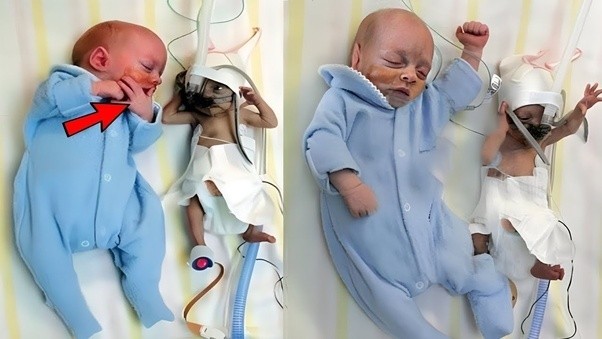Mom gives birth to twins, then she realizes one of them isn’t her own skin. There are several kinds of feelings; first, it’s surprise most of the time, which may have some impact on other feelings, especially if you had previously had a single pregnancy. I think the main thought is to imagine how to take care of two babies after birth instead of one. The prospect to go through a double delivery today is less worrisome because the trend today is delivering twins by cesarean section. This is part of your prenatal care. You’ll be gaining more weight, and the abdomen will be larger, causing more physical stress on your posture, with an increase in the swelling of your legs. You may feel more uncomfortable if you had a previous single pregnancy. Subjectively, you may feel many babies’ movements, the desire to deliver two babies, provided you know their sex and have such an important part in their lives since the beginning. Making a plan for such an important function will dominate any other thoughts. I’ve had to get used to the constant looks and questions whenever we’re out in public.
Sarah had barely come to terms with losing two babies in six months when she found out she was pregnant again, completely terrified. Sarah called the doctor to set up an ultrasound, praying that this time she’d carry the baby to term. But she knew it wouldn’t be easy. With her two older children, she had battled nine long months of morning sickness and other pregnancy complications. During the ultrasound, I began asking the tech questions: What’s the heartbeat? Is the baby okay? The mom of four first wrote on Love What Matters. She couldn’t tell me much, so it made me even more nervous. Sitting on the bed, waiting for what seemed like hours, two doctors and the tech finally walked in. The doctor starts to explain, “Everything’s fine; the heartbeats were 157 and 152.” It was a rough pregnancy. Sarah sat there in complete and utter shock.
“What did he mean, two heartbeats?” It turned out she was carrying a boy and a girl, whom she decided to call Malachi and Malaysia. Although both babies looked healthy, doctors warned Sarah that multiple pregnancies could change at any point. “Throughout my pregnancy, it was rough,” she said. “My cervix was shortening, and working full-time wasn’t helping. Malaysia was moving like crazy, which actually was a great thing.” But with a one-year-old on the brink of turning two and a five-year-old going on 21, the whole pregnancy certainly was a task. “I woke up in pain, but it wasn’t until Sarah’s third trimester that the complications truly set in. Doctors were concerned that Malaysia wasn’t growing as well as her brother. Although this is common with twins, the situation was serious enough that Sarah was kept in the hospital for observation for two days.
Upon arriving home and laying down, I woke up in pain,” she said. “I again rushed to the hospital; my blood pressure and my protein were extremely high; I had preeclampsia.” They started having me sign forms for a c-section; all I could do was cry. So, in just 28 weeks, Sarah’s twins entered the world. They were tiny, with Malachi weighing just over a kilogram and Malaysia weighing 879 grams. “I was the only one in the room besides the 10 nurses and doctors,” Sarah said. “All I could do was cry as I saw them working on my children running around.”
The next couple of days, weeks, and months were tough on this mama and her little warriors. There were a few terrifying episodes where my little girl stopped trying to fight for mommy, but she pushed through. No one could believe it when they were born; the twins were so tiny that it was hard to tell them apart. But as they gradually grew and filled out, to everyone’s amazement, they were total polar opposites. She was fair-skinned with bright blue eyes and blonde hair, and he was dark-skinned with brown eyes and black hair. “A lot of nurses didn’t know how to approach me,” Sarah added. “I got comments like ‘I’ve been a nurse for 23 years and have never worked with twins like them’ and ‘It’s weird having a white twin and a black twin.’ No one could believe it; ‘Do they have the same father?'” When the twins were finally allowed to go home, these kinds of reactions only became more common when we were out in public. “I’ve gotten questions like ‘Are they adopted? Are they twins? Do they have the same father?'” Sarah added. “It’s amazing the things I get asked. They’re constantly getting looks from people.”
“They couldn’t be any more different from their hair color to their skin, eyes, their attitudes, and little personalities. My babies fit right in with our family,” she said. “But despite the stares, Sarah wouldn’t have it any other way. “My now six-year-old being dark-skinned and my now two-year-old being fairly fair-skinned, my babies fit right in with our family,” she said. “All four of my kids are total opposites but best friends.” The proud mama advises parents to make the most of their kids when they’re young; “It flies by, so everybody in the situation, pray and appreciate every little second because they seem small now, but you’ll blink and they’ll be adults making life decisions.”
There were enough differences for me to not have noticed that I was expecting two babies rather than one, and in fairness to myself, I should add that apart from one slightly fae friend who said nothing at the time, nobody else had noticed either, not even my doctor. In retrospect, there were clues, but I, and later we, didn’t recognize them at the time. So here they are in approximate chronological order: Firstly, I was expecting my first baby; she and I used to have long unspoken conversations—no words as such, but definitely two-way. This time around, what I mostly got in response was a confused jumble of noise; I couldn’t make any sense of it, but it was rather worrying and disturbing. So I largely shut down communication. Cherish them now, every moment you have with them. Our baby was very different.
Every year, millions of babies are born, and every single one of them is different, with varying skin colors, eye colors, hair colors, and their own characteristics. It’s what makes them unique. However, every year, approximately 5 in every 100,000 people are born with albinism. This rare disorder is still relatively unknown because so many varying forms of it exist. As we said, we’re all unique.
Nevertheless, many scientists have dedicated their whole lives to finding out even more about the disorder, its causes, and its effects. What these dedicated researchers have found is that albinism is a congenital disorder that can be found within people of all races, ethnicities, ages, and genders, and is the result of a partial or complete lack of pigment called melanin. Amongst the majority of the general population, melanin, along with genetics, determines your skin color, your eye color, and your hair color. However, those who lack this pigment may develop stark white hair, white skin, and pale eyes. Although albinism does not pose an obvious health risk, those with albinism may suffer from eye conditions such as partial vision and blindness, as well as sensitivity to light. Albinism is a lifelong condition, but it’s rarely ever harmful and does not require treatment because it’s a genetic disorder, which cannot be treated. Although those with albinism may need to attend eye tests more frequently and be careful when in direct sunlight, albinism does not get worse over time or with age. Most of the time, signs of albinism are found at birth, but there are many cases where it’s been found later in life. There are also cases where doctors are baffled by the distinct characteristics a baby exhibits, just like little Bence with his stark white hair. Doctors were convinced that Bence was born with albinism, but what’s the truth behind this white-haired baby, a little baby with a big difference? Let’s be honest; we all get a bit worked up about our looks—yep, even you—and we all wish we could turn back the clock to when we were youngsters, to a time when wrinkles didn’t exist, we had no idea what age spots were, and the only bags we had to worry about were the ones we took shopping, not the ones under our eyes. The best thing about being a kid? Not spending hours choosing the right hair dye to cover your aging white hair. But this baby was different. Bence was born in Hungary and was born with a full head of white hair. When Bence was born, the whole process ran smoothly, with no complications or problems. Bence’s parents were pleased to find their baby was healthy and happy. It was a normal birth; he weighed in just under 12 pounds, which is slightly larger than the average weight, but not uncommon. He stood (well, not literally; that would be impressive) at 21 inches high and was born with a full head of hair. Again, not uncommon. But what took his parents by surprise was the fact that his hair was bright white. After getting over the initial shock of Bence’s full head of hair, his parents and doctors decided to test his vitals to ensure that he was really as healthy as he seemed from the outside. Thankfully, all of his vital checks came back positive, and their baby was perfectly healthy. But there were still a few questions floating around: What caused his hair to be so white? Soon, the word albinism began to play on the doctors’ lips. The doctors continued to talk amongst themselves to determine the cause of Bence’s white hair, and all came to the conclusion that Bence could, in fact, have albinism. Albinism is a congenital disorder that prevents the human body from creating melanin, a pigment which determines hair color, eye color, and skin color. Despite the fact that he did not carry all the characteristics associated with albinism, his stark white hair color did. To finally get an answer, doctors tested Bence’s blood and melanin levels. The main doctor in charge of Bence’s case was Dr. Zoltan Coomer, who, after testing Bence’s blood, found that his blood did carry the low levels of melanin synonymous with albinism. He concluded that this low level was a definitive contributing factor to Bence’s unique hair color. However, this did not answer all the questions. Bence’s skin was unlike any other albino case; he was not missing the pigment in his skin, only in his hair. So why was it different? As more and more questions surrounded Bence’s case, many doctors began to speculate that his white hair may not be the direct cause of albinism; instead, it could be the cause of prenatal stress or another illness. Many babies are prone to anxiety and stress while in the womb if the mother is feeling anxious or stressed, causing complications and problems with the baby’s health when born. Finding out the cause of Bence’s white hair wasn’t a quick diagnosis, and Bence began to spend more and more time in the hospital. Just enough time for the nurses and doctors to fawn over him with his adorable looks and unique hair. Bence soon won over the hearts of the workers, who nicknamed the child “Prince Charming.” As time went on, Dr. Coomer began to suspect that the loss of pigment in his hair is only temporary, and that his melanin levels would increase over time. Like most parents, Bence’s mom and dad couldn’t help but show off their baby boy on social media and the internet, sharing updates on Bence’s condition. Thanks for reading.





